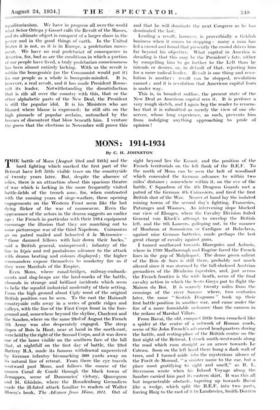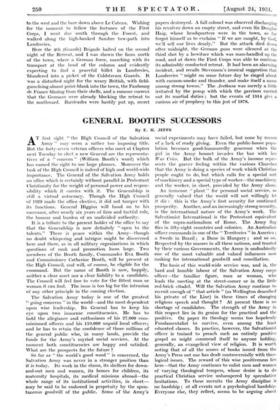MONS : 1914-1934
By C. H. JOHNSTON
THE battle of Mons (August 23rd and 24th) and the hard fighting which marked the first part of the Retreat have left little visible trace on the countryside of twenty years later. But, despite the absence of relics, there is an attraction about this spacious theatre of war which is lacking in the more frequently visited battle-fields of the trench zone, for, when contrasted with the ensuing years of siege-warfare, these opening engagements on the 'Western Front seem like the last dying flicker of the war of manoeuvre. Even the appearance of the actors in the drama suggests an earlier age ; the French in particular with their 1914 equipment encourage the illusion that they are marching out to some picturesque war of the third Napoleon. Cuirassiers go on patrol mailed and helmeted a la Meissonier- those damned fellows with hair down their backs," said a British general, unimpressed ; infantry of the line in kepis and red pantaloons advance to the attack with drums beating and colours displayed ; the higher commanders expose themselves to musketry fire as if they were Marshals of the Empire.
Even Mons, where canal-bridges, railway-embank- ments and slag-heaps are the land-marks of the battle, abounds in strange and brilliant incidents which seem to belie the squalid industrial modernity of their setting. From the high ground about Ciply most of the original British position can be seen. To the east the Hainault countryside rolls away in a series of gentle ridges and valleys, with the line of the First Corps front in the fore- ground and, somewhere beyond the skyline, Charleroi and the Sambre, where on the same 23rd of August the French 5th Army was also desperately engaged. The steep slopes of Bois la Haut, near at hand in the north-east, were held by the right of the Second Corps, and it was down one of the lanes visible on the southern face of the hill that, at nightfall on the first day of battle, the 23rd Battery R.A. made its famous withdrawal unperceived by German infantry bivouacking 300 yards away on its natural line of retreat. From there the eye travels westward past Mons, and follows the course of the unseen Canal de Conde through the black towns of Jemappes, scene of Dumouriez' victory, Quaregnon and St. Ghislain, where the Brandenburg Grenadiers made the ill-fated attack familiar to readers of Walter Illoern's book, , The -Advance from Mims, 1914: Out of sight beyond lies the Eseaut, and the position of the French territorials on the left flank of the B.E.F. To the north of Mons can be seen the belt of woodland which concealed the German advance to within two miles' distance ; somewhere within it, on the eve of the battle, C Squadron of the 4th Dragoon Guards met a patrol of the German 4th Cuirassiers, and fired the first British shot of the War. Nearer at hand lay the isolated mining towns of the second day's fighting, Frameries, Paturages and Wasmes. An intervening slope blocked our view of Elouges, where the Cavalry Division foiled General von Kluck's attempt to envelop the British left, and the 9th Lancers, galloping out, in the manner of Monbrun at Somosierra or Cardigan at Balaclava, against nine German batteries, made perhaps the last great charge of cavalry against guns.
I turned southward towards Blaregnies and Aulnois, where in 1709 Marlborough and Eugene faced the French lines in the gap of Malplaquet. The dense green salient of the Bois de Sars is still there, probably not much altered since it was stormed by the tall-shakoed Austrian grenadiers of the Blenheim tapestries, and, just across the French frontier is the wide heath, scene of the final cavalry action in which the Scots Greys put to flight the Maison du Roi. It is scarcely twenty miles from the crossings of the river Samme where, two centuries later, the same " Scotish Dragouns " took up their first battle position in another war, and came under the fire of a more formidable ordnance than the cannon in the redans of Marshal Villars..
From Bavai, the old, compact little town crouched like a spider at the centre of a network of Roman roads, scene of Sir John French's advanced headquarters during the battle, and resting-place of the British centre on the first night of the Retreat, I struck south-westwards along the road which runs straight as an arrow towards Le Cateau. Soon on the left hand there hung a dark wall of trees, and I turned aside into the mysterious silence of the Foret de Mormal, " a sinister name to the ear, but a place most gratifying to sight and smell," as R. L. Stevenson wrote when his Inland Voyage along the Sambre carried him past its eastern skirt. It was this all but impenetrable obstacle, tapering up towards Bavai like a wedge, which split the B.E.F. into two parts, forcing Haig to the east of it to Landrecies, Smith-Dorrien to the west and the bare down above Lc Cateau. Wishing for the moment to follow the fortunes of the First Corps, I went due south through the • Forest, and walked along the high-banked Sambre tow-path into Landrecies.
Here the 4th (Guards) Brigade halted on the second night of the Retreat, and I was shown the farm north of the town, where a German force, marching with its transport at the head of the column and evidently • expecting to find a peaceful billet in Landrecies, 'blundered into a picket of the Coldstream Guards. It was a disturbed night for the weary British, with field- guns firing almost point-blank into the town, the Faubourg de France blazing from their shells, and a rumour current that the Germans were already blocking the retreat to the southward. Barricades were hastily put up, secret papers destroyed. A full colonel was observed discharging his revolver down an empty street, and even Sir Douglas Haig, whose headquarters were in the town, so far forgot himself as to exclaim " If we are caught, by God, we'll sell our lives dearly." But the attack died down after midnight, the German guns were silenced at the third shot by a howitzer which was man-handled up the road, and at dawn the First Corps was able to continue its admirably conducted retreat. It had been an alarming incident, and recalls Stevenson's ironical suggestion that Landrecies " might on some future day be ringed about with cannon-smoke and thunder, and make itself a name among strong towns." The Arethu.sa was merely a little irritated by the pomp with which the garrison carried out its martial duties ; but the events of 1914 give a curious air of prophecy to this jest of 1878.



































 Previous page
Previous page